
Blog 6. Varanasi – Getting closer to the Buddha and taking to the Ganges for a celebration of the River God
Day 4. Sunday 17th November – Amritsar to Varanasi
In transit to Varanasi via Sarnath
Time to leave the lovely city of Amritsar today. Too early for breakfast so down I pop to reception to pick up our picnic box for breakfast. Those who joined me in blog four last week will remember the contents of the box had been agreed twice. As my grandfather, a master cabinet maker used to say “Mark it twice and cut once”….he was a stickler for accuracy.
There on the counter were two massive boxes from Tarteria, one for each of us. Inside the box – not what we had ordered at all! A cheese sandwich, a croissant, a muffin, mango juice, an apple and a sachet of tomato sauce. I was already struggling at having to miss my spicy Indian breakfast and detest croissants and muffins (unless in the mood) and even then they have to be tip top fresh; these weren’t. The ever lovely doesn’t want a cheese sandwich at 05:00, neither of us want to eat an apple without peeling it first (another Delhi belly avoidance tactic). In the car I eat both sandwiches and we both drink our juice. We leave the rest for Heera to do with as he wished. Jasprit, the meet and greeter from episode three is really not one for chat but Heera again proved to be good company.
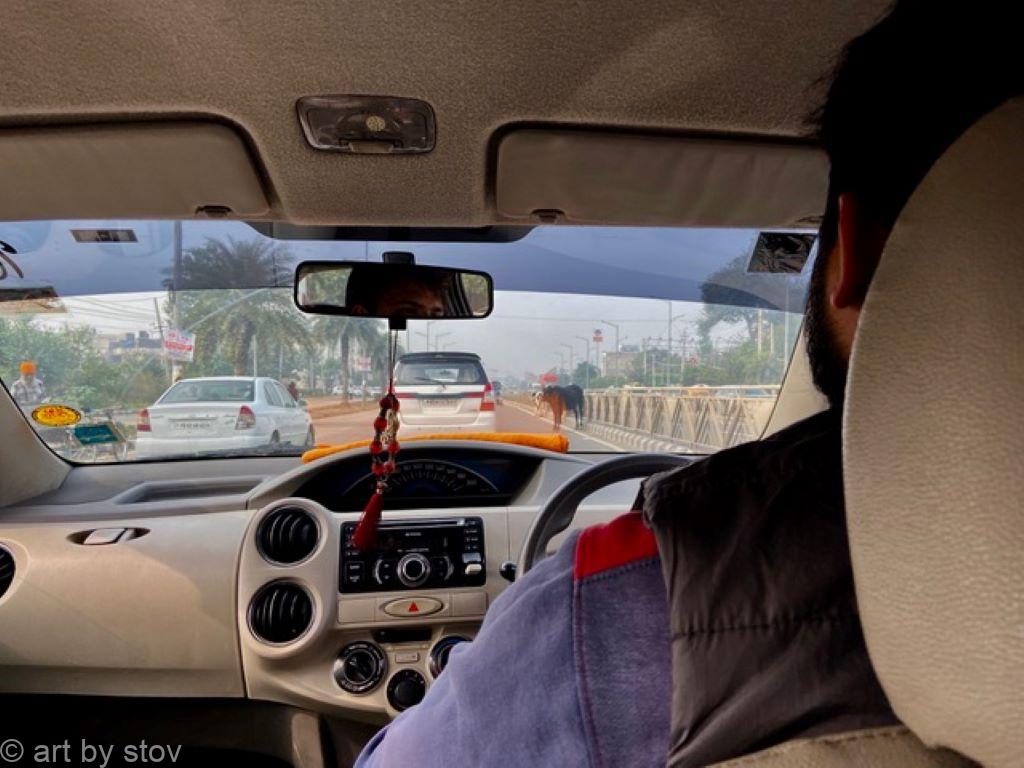
Turned left out of the hotel onto the Grand Trunk Road (GTR). Heera takes the first slip road to be confronted by a large lorry and a bullock cart coming up the slip road the wrong way. Impasse! How we came out of this I do not know I shut my eyes fearing an impact.
At the airport Heera warmly wished us well for our travels ahead. Jasprit silently found us a trolley and dumped us at the door to the terminal. Walking inside we were confronted by two scanning machines? There was no signage and no one to ask. We put our bags through the first of the scanners and proceeded to the check in desk. It looked as if we were going to have a busy flight there was quite a queue. When we were finally beckoned across to check in we were asked where our Air India security baggage tags were. Looking puzzled it was explained that we had to go to the second scanning machine where, after successful scanning someone applied a security tag to each of our hold and cabin bags. We were dispatched to re-scan. Thankfully, obeying the queueing rules allowed us back in at the front. Very polite throughout, there wasn’t a single titter or tut from the queue, just a general acceptance that we can’t always get things right in life.
Now for security, we failed that test too! Again there was a big queue and again no instructions. We did the usual routine, a separate tray for metal items, electronic gadgets, tray for coat and boots and tray for back pack. Off they went into the scanner. The scanner reversed and out they came again. Then back in they went and finally out with barked instructions to take everything out of your backpack. This required another two trays which were not immediately present. By now half of my stuff was through the scanner causing a blockage and half was still landside in a queue and gosh what a queue it had now become! I must admit at this stage I was more than a little peeved… The ever lovely quite rightly disowned me and I was left running back and forth to the scanner output tray taking ten minutes or more to repack my possessions. All of this could have been avoided with a simple sign or comment between check in and security but hey…….
We went through to the only visible lounge and waited for our flight to be called. Five minutes before our flight we still couldn’t see it on the departure screen and asked a local passenger what the delay was. Oh, Air India, you need the lounge upstairs. Only 2 minutes before our flight now – panic! Breathless, we reached the security desk at the top lounge and were ushered through to the plane. I have never been last on a plane in my life, and the looks we received made me vow never to be so again.
The internal flight was only 55 minutes long but included food, which was good news as the ever lovely was quite hungry by now. Juice, Water and a spicy savoury pastry stuffed with vegetables. With it came the inevitable sachet of Tomato sauce. Indians love tomato sauce, you get a sachet with almost anything savoury. When you see them eating crisps it is a pretty good chance it is Lays Spanish Tomato flavour or a local equivalent.
We Arrived in Delhi with a short delay to our transfer So we had time for a coffee and a bun. The food hall is upstairs at Delhi airport and as we rose on the escalator I snapped another of my “men at work” pictures on my iPhone. The windows are at 100 feet top to bottom. The window cleaner was climbing from one level to another like he was scaling a sheer cliff face and with no discernable safety equipment.
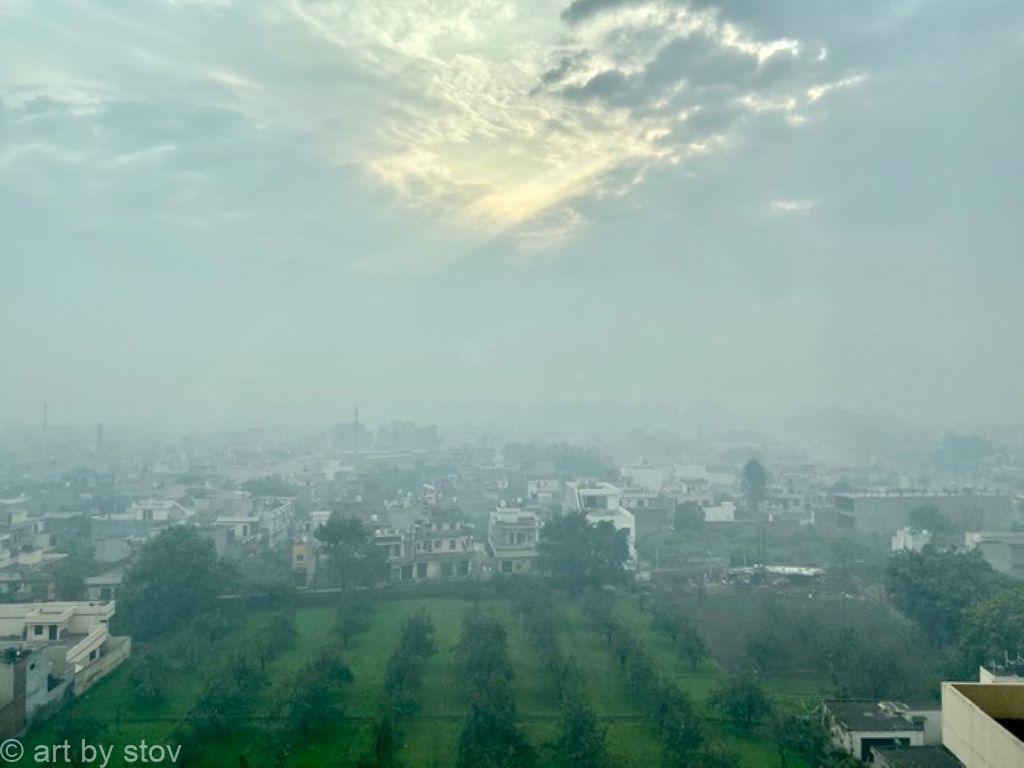
I picked up a copy of the Hindustan Times and read selected articles for mutual consideration on air pollution and safety on the roads. Whilst flying we saw a few fires in the fields. These fires would relate to stubble burning and it was harvest time across much of the sub continent. We pondered on how serious the Indian Government was to cut down on this major source of air pollution. The answer is that they had legislated to ban the burning and there was one article in which a police captain had been suspended for ignoring a reported case of burning. With nothing to compare against, the road traffic statistics appeared reasonable,though somes parts of the country were astronomical in comparison to others.
Another flight, this time Air India to Varanasi. We were in the air for an hour and a half and served hot food. It was deliciously awesome if not a little dangerous to eat. Moist Dahl, rice and chapati main with a side of set yoghurt. For pudding carrot and papaya pudding. Only one accident. My shirt now has a yellow bindi!
We were met at Varanasi by Imran who’s role was to take us to our guide at their office. There he alighted and through the open car window introduced Visnuth (?). Why the (?) you ask? Well, The ever lovely and I had different recollections of his actual name and I may even have two. The man with three names then took us to Sarnath.
Sarnath is one of the four most holy sites for Buddhists. Buddhism used to be very large in India but now only only represents 0.7% of the population. That is still some 8 1/2 million followers.
Buddhist temples take the form of a solid tower called a stupa. There were two of great significance at Sarnath. The first, which is still very much intact, is where Buddha is purported to have preached his first sermon. Here the faithful were doing laps in a clockwise fashion, round and round and round they went chanting their mantras. The second Stupa reduced to only about twelve layers of brick was where the Buddha’s ashes were said to have been interred. Here there was a gang of faithful, armed with buckets of water and toothbrushes. They appeared to be very assiduously cleaning the stupa by the mini brush process.
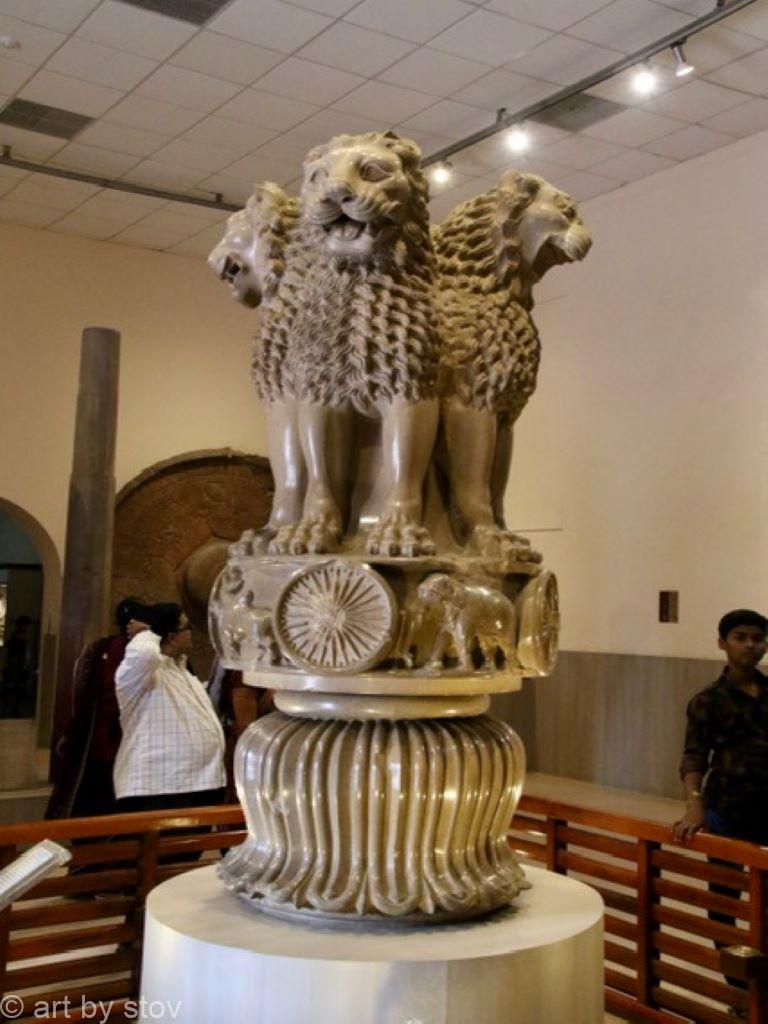
Another thing of great significance to the whole of India (not just Buddhism) is the column headed by four lions sitting on their haunches – the Four Lions of Ashoka. The column head sits in the nearby museum but the column itself was in pieces under a canopy near the ashes stupa. The four lions are a national emblem for India.
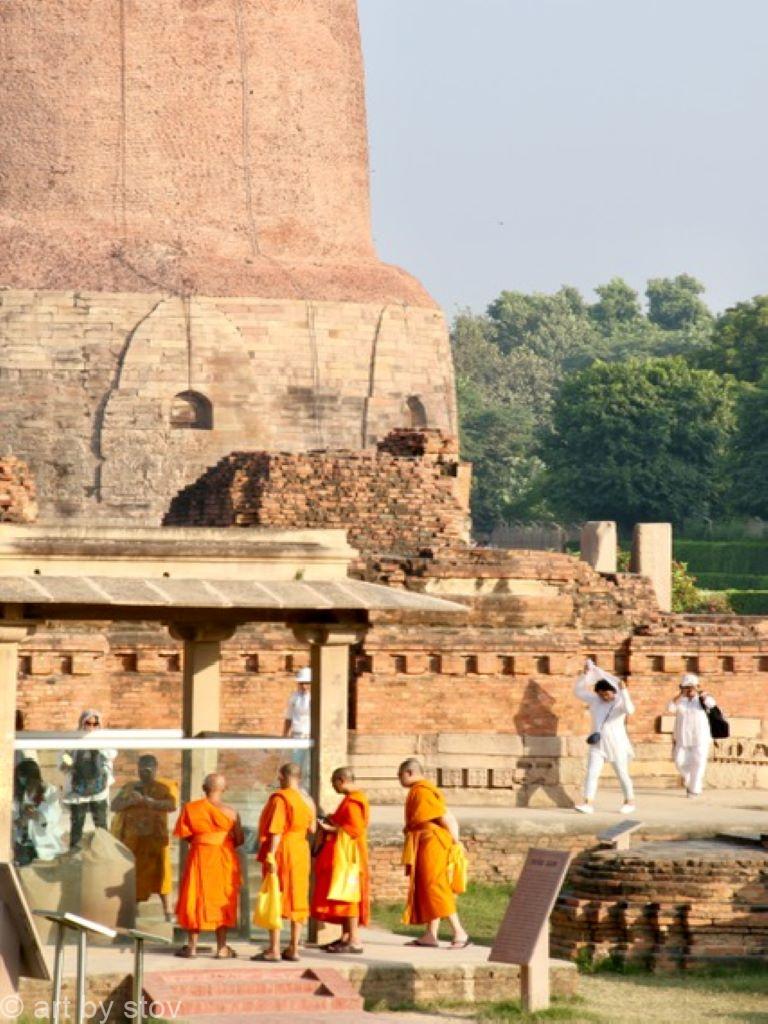
The whole site was very tranquil. There were many monks in their saffron coloured robes obviously paying homage. Clearly devout, humble and without possessions….oh wait a minute, that one has a Canon E1D and a very nice lens…that’s about £3,500 worth. Or to put it in context about five times the annual earnings of our driver.
Onwards to Varanasi. We were anticipating a heightening in the intensity of our India experience, and we were not wrong. We had already been told that the streets in Varanasi were so narrow that there was not even room to get a donkey in them, let alone a car. We were to approach by boat. We we drove down to the Rajghat at the very northern edge of one of the most ancient cities on earth. Varanasi is so ancient that it has more than one name, the locals still refer to it as Benares but before that in the dim distant years of world civilisation it was called Kashi.
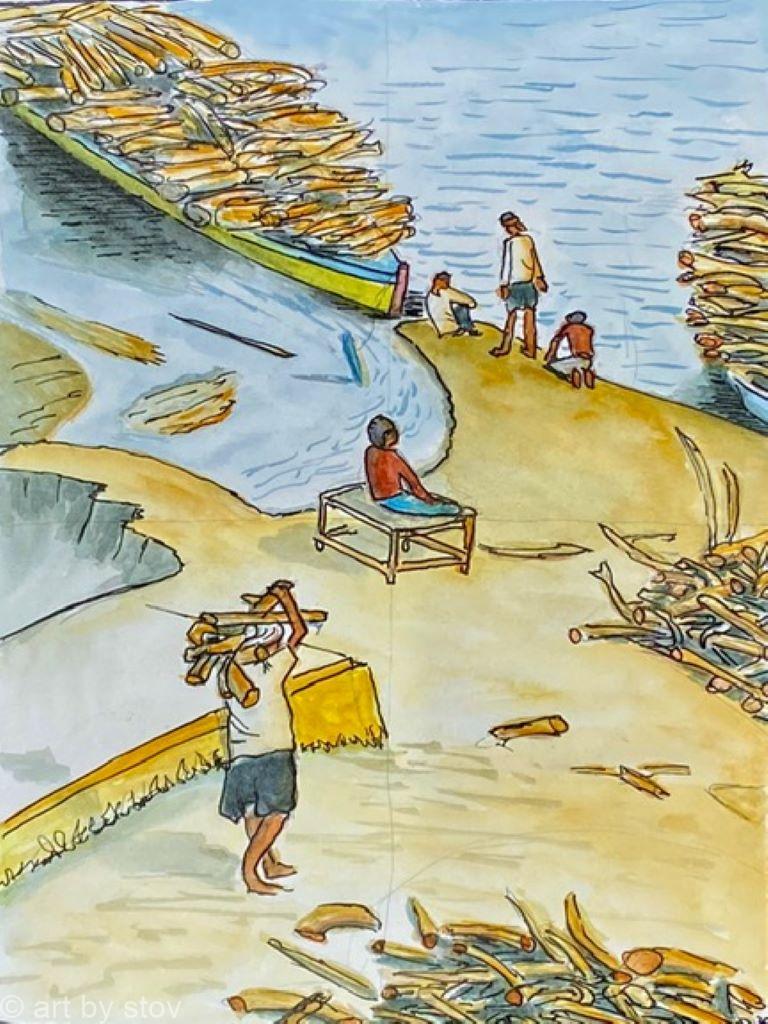
Anything of significance is transported by boat. The Ghats are steps leading down to the river edge at which, or near which the boats would be tethered. At the side of the Rajghat, looking towards the iconic rail bridge built in the 1890s at the height of the British Raj, we could see the timber being brought down and loaded onto barges for onward shipment to the two burning ghats. Whole forests of wood weighed barges down to the waterline and still they piled the combustibles on. We were told it takes on average 500-600 kilograms of wood to completely cremate one body at those ghats.
As we awaited the hotel river chariot the sun was setting over the city behind us. A most tranquil setting, the only thing disturbing the quiet was the flapping of many colourful homemade kites flown by local children in the late afternoon breeze. Kite flying is a massive thing in India for children and adults alike, there being festivals and competitions. The strings in these competitions are covered in fine glass crystals all the better for sawing through a competitors string and thus ensuring victory.
The boat arrived and we had our first taste of Varanasi boarding. There was no jetty or gangplank instead we had to walk across the extremities of other boats lying nearer to the shore line. The hotel boat crew, our guide and our driver all helped us traverse the yawning gaps, we had an ever increasing sense of nervousness as our bags remained on the strand completely unattended.
The scene was tranquil. We both watched in silence taking in the vista unfolding before us. The only noise came from the chugging of the diesel engine which looked like it belonged on the African queen rather than a 21st Century water taxi. After ten minutes or so the boat hove towards the shore and we took a leap onto what we anticipated would be the terra firma of the hotel pontoon. never has anything so solid looking belied it’s true jelly like nature as it lurched from left to right with every step. We rushed across it to the stone steps of the Guleria Ghat named after our hotel.
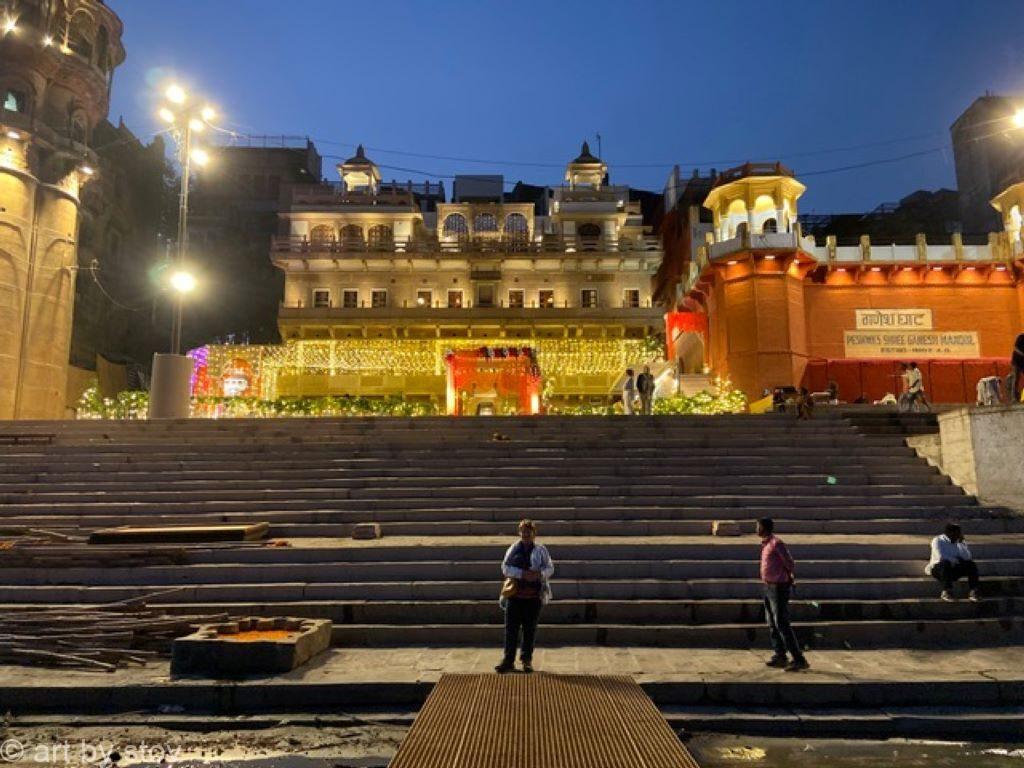
Hotel Guleria is a beautifully restored 17th century haveli. Warmly welcomed with gifted silk his and hers scarves and a swift check in we headed towards our room. The lift was so small we played sardines whilst the porter took the stairs. After such an eventful day’s travelling we thought we would have a chance to relax, take a shower or at least a quick splash and dash. No such thing Visnuth (?) informed us that he would pick us up in half an hour to take us on a boat trip up the Ganges to see the Aarti ceremony.
The reason re embarked so soon after our arrival was that we were to be rowed up the river. Off we three headed in a massive heavy boat that would have seated twenty and this poor man, who looked like a good meal would do him no, harm pulling against the quite strong current to row us up the river.
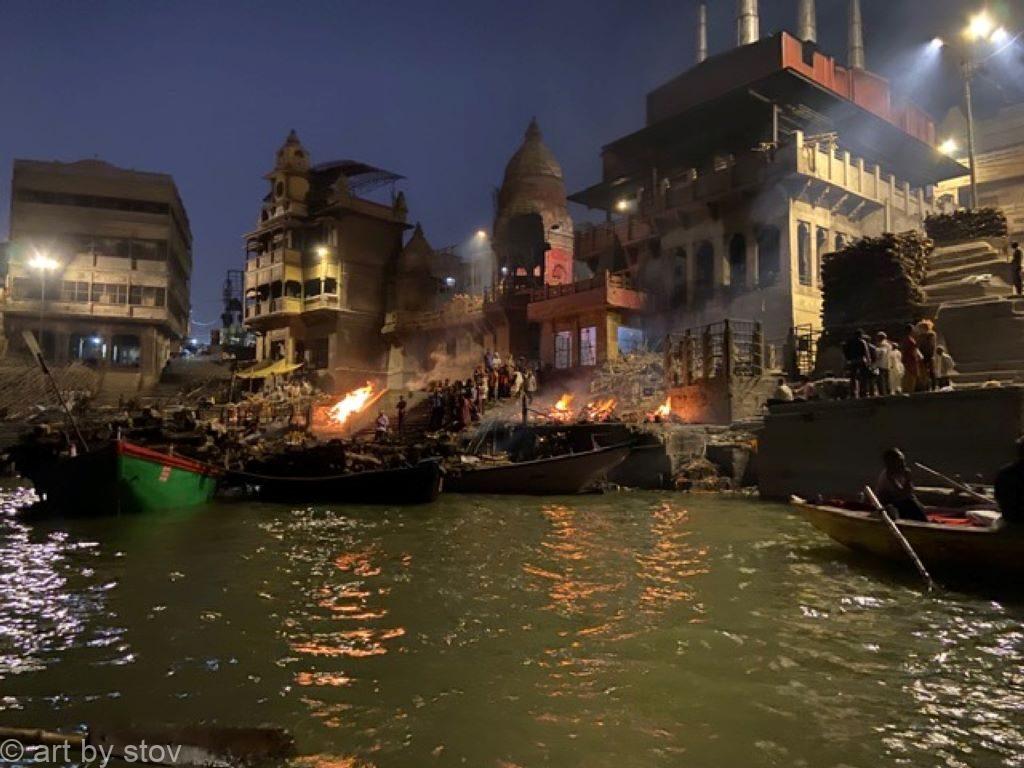
Though there was a veritable flotilla of boats headed toward the site of the Aarti ceremony we stopped for ten minutes at the Manikarnika Ghat. This is the main burning ghat in Benares. The later in the day the body of the deceased was cremated the more likely they were to receive moksha; release from the never ending cycle of birth, death and reincarnation. Devout Hindus moved to Varanasi to die. It may be highly desired but the late evening burning is also the most expensive and beyond the reach of all but the wealthy. The fires were burning bright tonight.
At last we arrived at the Dasaswamedh Ghat and our rower leapt to the front of our boat jostling us forward tying and untying and retying other boats ropes to gain a few centimetres of ground. The aim is to get as close as possible to the theatre evolving before us. I don’t know which was more entertaining the aarti, or the boat crews constantly jostling. I didn’t know what to expect, so I took the new iPhone 11 (The ever lovely and I had each purchased one the weekend before we left home just to add two the pressure of getting things ship-shape for our departure). The camera is awesome for night photography, much better than the iPhone 6 which I have now donated to the ever lovely’s mum. Remembering back to when in Port En Bessin on our Normandy holiday, fed up with trying to get a night shot of the fishing boats returning into the harbour using my SLR Camera I turned to the phone and ‘blow me down’ if it didn’t take the perfect picture at the first attempt!
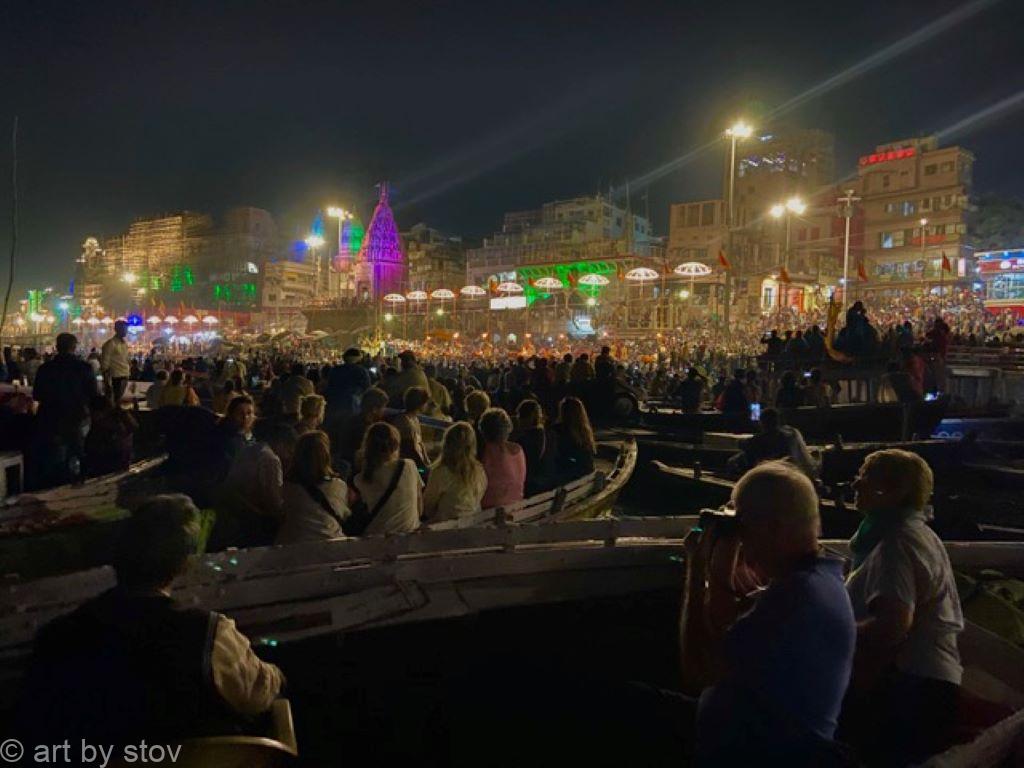
Anyway I digress. Back to the aarti or, aarti puja to give it it’s full name. Puja is Hindi for prayer. There are several puja during the day but the aarti puja was the one which thanked the gods at the end of the day and effectively closed the temple. Now at Varanasi the whole of the Ganges is the temple. So they need a big bold and brash aarti finale to the day. Picture the colourful scene, a crowded river side, a crowded river and nine twenty four feet tall umbrellas all brilliantly lit. Under each umbrella was a podium.
So this is the order of play:
- Several men spend fifteen minutes sprinkling vast quantities of orange marigold petals on and around each podium
- A man approaches each podium and climbs onto it. The men are wearing what appears to be gold lame ceremonial robes.
- Bells start ringing way above the podiums. Acolytes somewhere are pulling ropes to achieve this.
- Not content with this each man has a small handbell which he then tinkles
- After a bit the handbell is replaced by a conch and all nine blow a pretty loud bellow
- They then each wave a yellow/golden flower tribute the size of a man’s wallet.
- Each then waves a large pot of incense
- The incense holder is replaced by what looks like a three dimensional jewish menorah complete with flames at each tip
- After a bit of menorah waving each man swaps for a large bronze device with one much larger flame
- The flames are waved around for a bit and then we have a return of the conch chorus
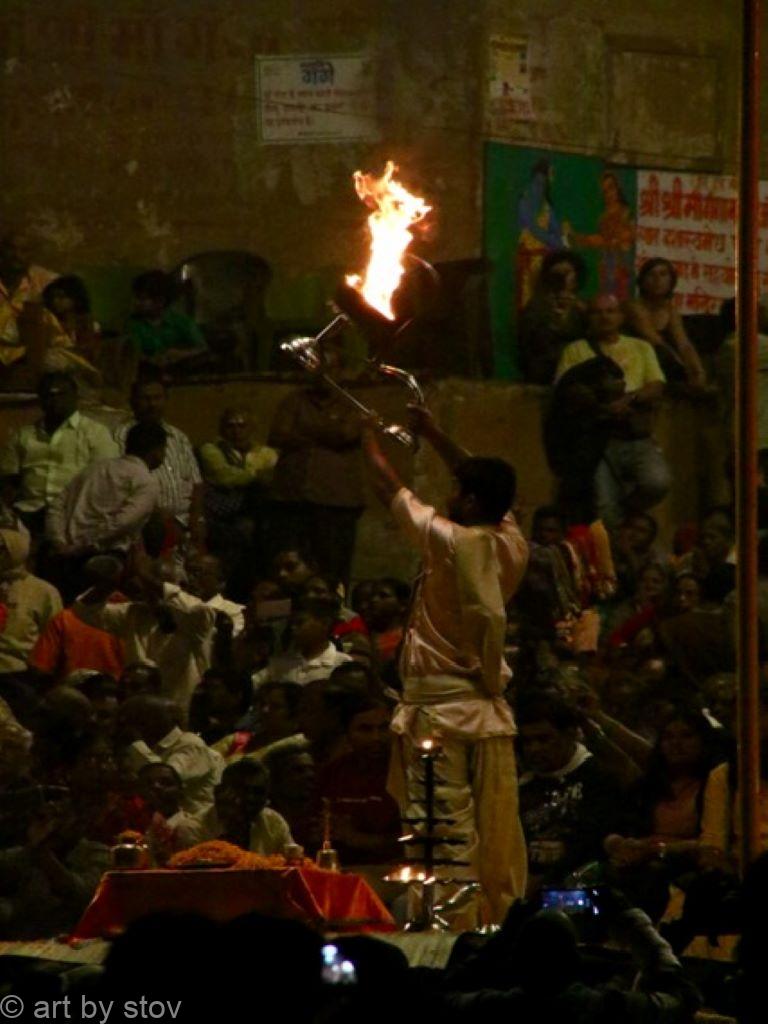
There may have been more after this but we were keen to disentangle and make haste from the crowd before the melee became too complex to negotiate.
Back to the hotel for dinner. Visnuth (?) made a big thing about Hotel Guleria being a Veggie restaurant and not serving alcohol. At the rooftop restaurant we were surprised to see, when presented with the menu, the first two things that leapt out were Ghosht and Murgh, Meat and Chicken. As we were eating so late we went along with the no alcohol, no one else was drinking any. The challenge came in trying to find something on the menu that existeed. As it turned out, the Rogan Ghosht was right up my street. Goat on the bone cooked in a dark, dark, almost black sauce. That and a plate of Jeera (Cumin) Rice was my idea of heaven. To wash it down a nice salty lassi. The ever lovely’s choice was not so easy, everything she fancied was not on the menu, in fact over half of the menu was a pure figment of the menu writer’s imagination. She ended up with the Murgh Makhani (chicken in a creamy sauce with a touch of mint). We agreed to share the rice and added a side of Bhindi Dupiaza, Okra cooked with tomato, onion and cumin. I also had a chapati added as I was ravenous, It was now nearly 21:00 and we hadn’t eaten since the Dahl on the Delhi to Varanasi flight. The Ghosht was delicious, not much meat, but so, so deep in flavour and texture. I could taste the smokiness of the black cardamom coming through the sauce and the now dissolved onions. The ever lovely washed down her delicious Makhani with a sweet lassi. We now noticed beer being brought to other tables but remained content with our choice to be alcohol free.
It was now well after 22:00 and we had been up since before dawn. We walked down the steps to our balcony, said goodnight to the twinkling lights of Varanasi being mirrored by the lights of the fishermen and boatmen still plying their trades and headed into our room.
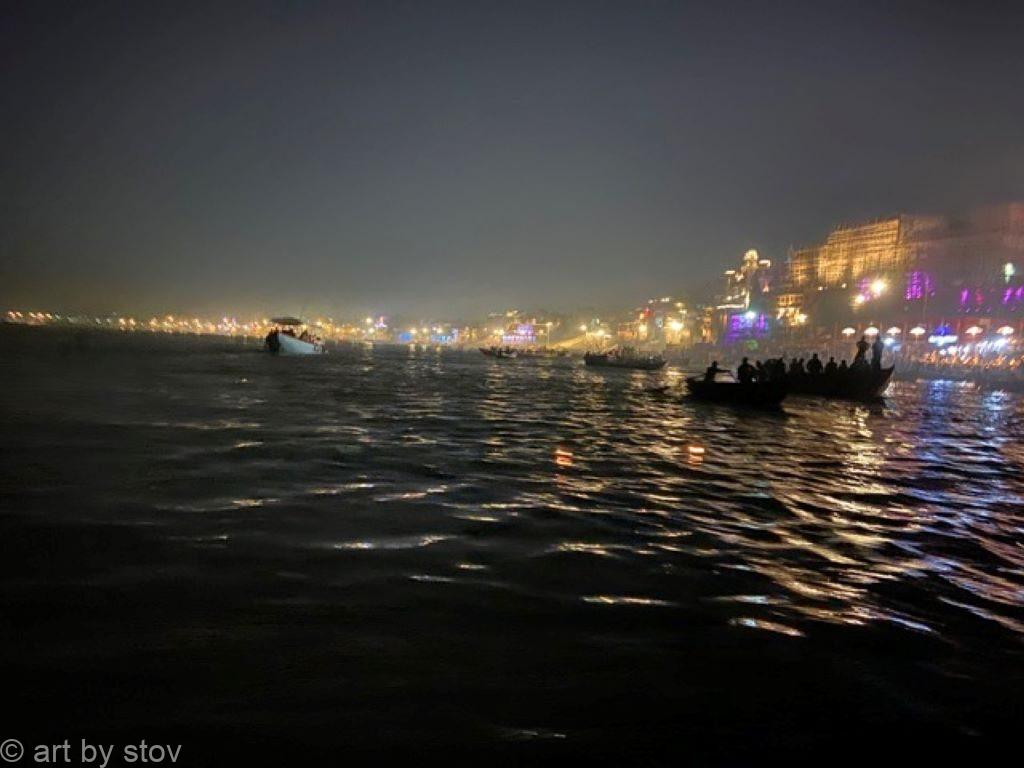
Able to relax at last we noticed the floor was littered with a carpet of small dead insects resembling mini grasshoppers. Then the smell hit me. The ever lovely said it was citronella. This was in the foreground but underneath there was a distinct undertone of mothballs. The source was a device on the wall just about pillow height on my side of the bed which belched out mothball fumes. This smell was to become very familiar over the next week as we travelled the remoter parts of central India. Too exhausted to care we slept well.
Join me next week for organic toothbrushes and my elevation to President
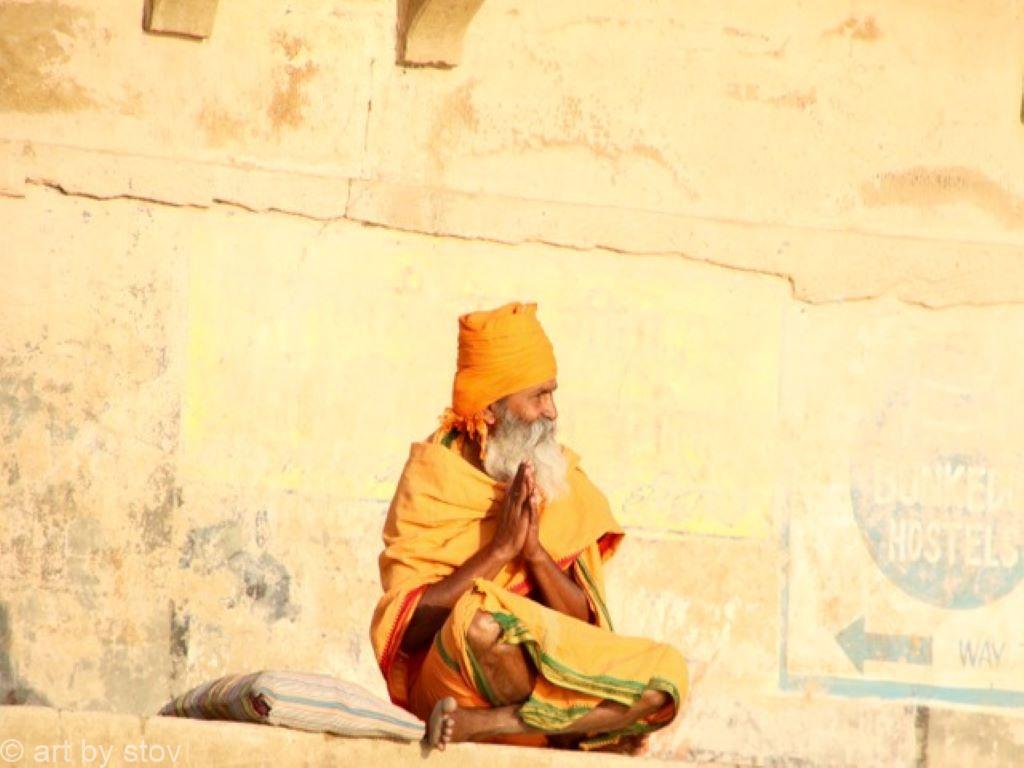
Missed an earlier Blog? Read about it here